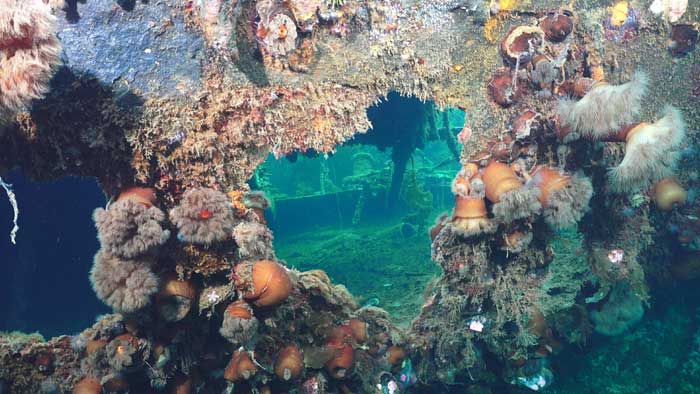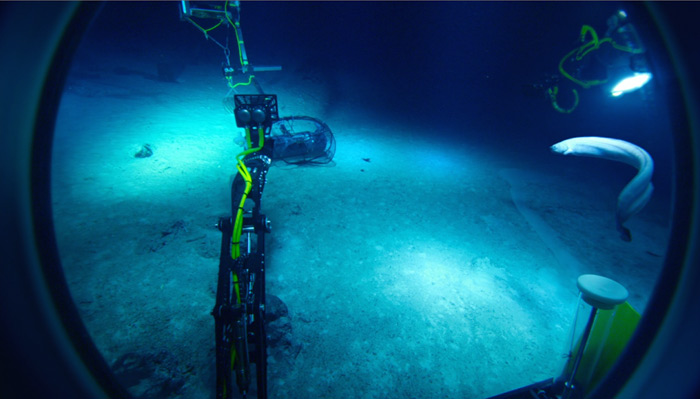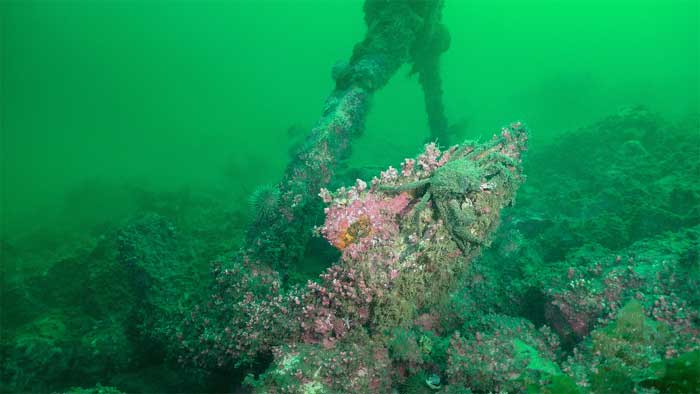|
WT 2016 Archives
2016/2/17
TITANIC, AVATAR AND SCHMIDT INSTITUTE
USED ADAM'S CAMERA FOR THEIR DEEPSEA SHOOTS
MEET ADAM

Scroll down for interview with Canadian inventor Adam Gobi
Interview below
Adam Gobi is the president and CEO at SULIS Subsea Corporation, developing leading-edge subsea cameras and robotics technology. The company was launched as a result of Gobi's PhD research and his experience working with famed Titanic and Avatar director and explorer James Cameron on a project called DEEPSEA CHALLENGE. WaterToday talked with Gobi over the phone in January. This is a transcription of that conversation.
Transcription: fiverr.com/andreagordon
Q&A
WaterToday: Let me take it from the top. I see very cool almost submarine-like units on your website. Are those yours? Can you tell me a little bit about what you do Adam?
Adam Gobi: SULIS started as an ocean engineering research development company where we primarily focus on deep sea camera systems. We build cameras for ocean exploration, science and film-making; that's our target.
WaterToday: How do you use cameras in science applications?
Adam Gobi: There are all sorts of ways. One of the primary uses is to serve as the eyes for a remotely operated vehicle (ROV), which you might be familiar with. It's essentially a tethered, remotely operated undersea robot.
The cameras are used to pilot the vehicle, and in terms of science and exploration, they are used to observe and interact with the environment. And you are making new discoveries almost every dive, imaging some creature or formation that has never been seen before. At this stage, only 5% of the ocean has actually been imaged by cameras or other sensors. That leaves 95% of the ocean that has yet to be explored.
WaterToday:So the cameras are the eyes of these ROV's and they also record some of the probably exceptional things that happen to go by. Are there some areas of the world that are of more interest to people than others or is it more like everybody wants to know everything, like on twitter.
Adam Gobi: Well, there are areas that are more biologically interesting than others. For instance, here off the coast of Newfoundland, there's a great deal of deep sea coral. When people think or hear of coral they think about coral reefs in Australia or the Caribbean, but there's coral in the deep sea as well. Scientists have discovered hot spots all over the north Atlantic, and have learned that this deep sea coral is an extremely important component of the Atlantic cod's habitat, and hence, must be protected to preserve the species.

WaterToday: That's amazing. Okay so then let me get to the camera part. Journalists on the whole will use a Canon 3-chip, is there something different about the technology that you use Adam?
Adam Gobi: There are a great range of cameras that have been used, including 3-chip, like you say. Sometimes, we've even designed and built the camera ourselves, from scratch. And then we have to create a pressure and water-proof housing around the camera, like a titanium or steel can, and develop optics so that it can see clearly under water; essentially, we transform that camera into an aquatic device. SULIS is really on the cutting edge of this stuff.
WaterToday: Sounds like it.
Adam Gobi: One of the systems we've just recently launched is a 4K, ultra high definition system, which is the next step beyond HD. It allows you to capture four times the resolution, and, when it comes to science based exploration, capture that much more information from the image and increase the potential for further discovery.
We keep tabs on new technology developments in the terrestrial camera industry, and build up technology to go in tandem; we strive to stay current with imaging advancements on land, bring them down below.
WaterToday: Tell me; I heard you say titanium case just a minute ago. Why titanium? What's the deal? That's a very expensive proposition isn't it?
Adam Gobi: It's very expensive, but it also has a very high strength to weight ratio. In a lot of situations, you're building a 4-inch or a 6-inch pressure can to house all these camera and electronics and optics and such. Depending on how big it gets and how deep you want to go, using a material like steel gets a bit too heavy, because you have to mount the unit on a vehicle.
When you're going really deep, titanium becomes worth the cost to save on weight. Aluminium gets used a lot as well, because it's also very light but it doesn't have near the strength of titanium. So aluminium can be used in a lot of shallower applications, but there are some where titanium is the only way to go.
WaterToday: How many atmospheres do you go down to? Is that the right term?
NOTE: One atmosphere is equal to the weight of the earth's atmosphere at sea level, about 14.6 pounds per square inch. If you are at sea level, each square inch of your surface is subjected to a force of 14.6 pounds. The pressure increases about one atmosphere for every 10 meters of water depth.
Adam Gobi: It is, though I usually speak in terms of PSI, rather than atmospheres. For instance the deepest part of the world's oceans is down in Marianas trench, and that is 11 kilometres, or 7 miles down. And that's a good 16,500 pounds per square inch of pressure.

WaterToday: Oh my!
Adam Gobi: That was actually how the company started. I was on a project called DEEPSEA CHALLENGE. It was run by James Cameron, who has a passion for ocean exploration and had been on many expeditions. He got a team of engineers to build a submarine, a one-man sub to go 11 kilometres down to the deepest point.
WaterToday: That's incredible. And your cameras were on that, were they?
Adam Gobi: Actually, I shouldn't say that Jim put together a team, as he was quite involved in development processes as well. He has a very acute engineering mind, and was in fact the co-designer of the submersible, together with Ron Allum. I was on his team of engineers, in charge of the camera systems. I developed all of the cameras that mounted on the submersible, to go 11km down and capture the trench in HD, 3D, and 4K. It was quite a project, and really ignited my passion for ocean exploration.
WaterToday: Wow! And were you in this thing? Or did you build the cameras for it and say "Okay, here you go."
Adam Gobi: Well, I served as engineering support on the expedition, but it is a one-man submarine, and there were only two pilots, Ron Allum and Jim Cameron.
WaterToday: Okay let me move back to what you do now. If you were looking to hire students out of university, what do you need their skill-sets to be?
Adam Gobi: I guess it depends on the aspect of the business. But in terms of building technology, it's engineers, and technicians.
At SULIS, we are a team of ten or so, with a core team of four engineers, including myself. All three of my engineers came out of Memorial University, here locally.
WaterToday: Oh neat. That's really good.
Adam Gobi: Yeah, and they graduated from various disciplines; mechanical, electrical, computer.
WaterToday: Here's an odd question. I am sure you've heard that Canada is supposed to submit a map of the ledge under the ice in the Northwest Passage for the United Nations Law of the Sea folks.
Adam Gobi: Right.
WaterToday: Having talked to scientists, ROV people, even icebreaker captains I get told all the time that this is quite the challenge, if it can be done at all. Could someone not use a unit that's been to the Mariana trench and adapt it to northern technology? Do you get those kinds of questions?
Adam Gobi: Well a vehicle going to the Marianna Trench is mostly designed to handle depth. And up in the Arctic, depth is not as much of a challenge because we're not really exploring too deep.
There's a lot of technology that, you know, was used in DEEPSEA CHALLENGER that's commonly used in many other subsea applications. We had to adapt it, as well as create new technology to go deeper. Certainly, within the general ocean technology community, there is a lot of technology that could be brought into the Arctic environment, and already has been. The Arctic presents a whole new host of challenges really. Especially when you consider that the air temps are less than the water temp, well below zero. You're constantly worrying about your equipment icing. It's quite a challenge to map that area, and autonomous underwater vehicle technology will be key.
WaterToday: Let me move back to you. Does a person take one or many cameras down underwater? can you tell me a bit about how this all works?
Adam Gobi: An ROV always has a lot more than one camera; especially a science ROV. You would have a pilot camera for situational awareness, to enable the pilot to keep track of his or her surroundings. You then have all sorts of ancillary cameras, checking instruments and/or pointing at your sample basket; and then at least one main science camera, your money shot. It would be a very, very high quality camera with really nice optics and a zoom capability.
WaterToday: How much is one of those, shot cameras, ball park figure?
Adam Gobi: Ball park is anywhere from $40,000 up to $150,000.
WaterToday: Well that's actually much cheaper than I thought. If someone had asked me at party I would have said it's probably in the millions you know.
Adam Gobi: Well the vehicle is certainly in the millions. I mean, the amount of technology it takes to build one of these vehicles and get it down at depth is pretty incredible.
And so it adds up to the millions pretty quickly when you think of it. All of the supporting technology needed to get the cameras and the scientific instruments down there to be able to collect samples and take video.
WaterToday: Not to mention the ship that took you out there, etc. etc.
Adam Gobi: Not to mention the ship, and the very expensive offshore daily rates.
WaterToday: I would imagine. How do you do things which are routine for a land cameraman, underwater? Simple things like say getting a white balance underwater?
Adam Gobi: The nice thing about an ROV is that there's no sunlight, after a kilometre or so of depth. So when we talk about offshore deep-sea expeditions, we're talking no sunlight. You don't have to worry about sunlight mixing with your lights, making colour-balancing difficult.
WaterToday: Where do you go from here? You've built an incredible camera. What is the next step for you as a company?
Adam Gobi: Well we don't want to be solely an R&D company. We're very passionate about building advanced technology for the underwater world, but we also want to be able to create repeatable products, to open the door for new opportunities. We want to get our product line out there.
WaterToday: Yeah. I could see a lot of ROV companies wanting to buy this technology. Do you get any calls the Canadian Space Agency or NASA to do develop this technology for space?
Adam Gobi: (chuckles) No we haven't heard from NASA yet.
WaterToday: That really surprises me because space seems to be on everyone's minds these days.
Adam Gobi: Absolutely. We actually know more about space than we do about our own oceans. There's always been quite a drive behind that, though.
But at least we are seeing an increased interest in uncovering the mysteries of our own oceans. And it's not only, non-profits, universities and such that are doing the work, but also philanthropists. I should tell you about another project we mention on our website and that's the work we're doing for the Schmidt Ocean Institute, which was founded by Eric Schmidt, chairman of Google, and his wife Wendy Schmidt.
WaterToday: Tell me more about it.
Adam Gobi: They're very passionate about the importance of ocean science, and want to help the world's leading scientists perform research offshore. They've retrofitted an offshore ship into a highly advanced vessel, named Falkor, specifically for conducting marine science. They accept proposals from from all over the world for cutting edge research, and if successful, the scientists gain access to Falkor, which is fantastic because one of the largest parts of a marine scientist's budget tends to be ship time.
By soliciting these proposals they bring some of the best researchers around the world together to perform very important research on Falkor. To go along with their ship, they're now building a fleet of ROVs with gradually increasing depth and research capabilities. They're going to build at least three, starting with a more traditional vehicle, capable of depths to 4,500 metres, all the way to full ocean depth. We've worked very closely with the Schmidt Ocean Institute, and have developed the core 4K imaging technology for this first vehicle. One of the cameras were putting on it is the Z70, which is the one you saw on our website.
WaterToday: Oh Congratulations! That really makes me happy as a Canadian to hear that kind of thing.
Adam Gobi: Thank you.
WaterToday: So you're gonna help Google Map the bottom are you?
Adam Gobi: (chuckles) Well, the idea of Google mapping the bottom is a whole other project, but essentially yes. SOI is doing great science all over the world with the Falkor, and soon with the ROV's they are building. We look forward to working with them throughout their vehicle development program, building camera technology specifically for the scientists and film-makers that will use them.
|
|